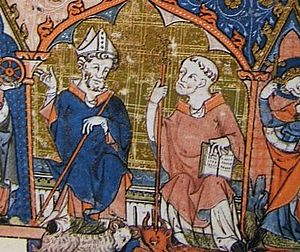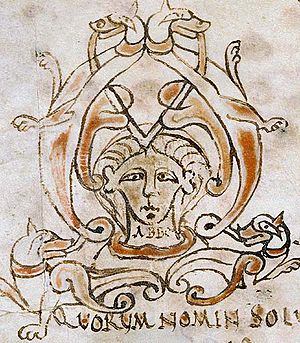Oswald of Worcester facts for kids
Quick facts for kids Oswald |
|
|---|---|
| Archbishop of York | |
 |
|
| Appointed | 972 |
| Reign ended | 29 February 992 |
| Predecessor | Edwald |
| Successor | Ealdwulf |
| Other posts | Bishop of Worcester |
| Orders | |
| Consecration | 961 |
| Personal details | |
| Died | 29 February 992 Worcester |
| Buried | Worcester |
| Sainthood | |
| Feast day | 29 February (leap years) 28 February (common years) 19 May (POCSP) |
| Venerated in | Catholic Church Eastern Orthodox Church Anglican Communion |
Oswald of Worcester was an important church leader in England who lived a long time ago. He was the Archbishop of York from 972 until he died in 992. He also served as the Bishop of Worcester at the same time.
Oswald came from a family with Danish roots. His uncle, Oda, who was also an archbishop, raised him. Oda sent Oswald to a famous monastery in France called Fleury Abbey to become a monk. After spending several years there, Oswald came back to England.
When he returned, his uncle Oda had already passed away. So, Oswald found a new helper in his relative, Oskytel, who had just become the Archbishop of York. Oswald's work with Oskytel caught the eye of another powerful church leader, Archbishop Dunstan. Dunstan helped Oswald become the Bishop of Worcester in 961. Later, in 972, Oswald was promoted to Archbishop of York. He kept his role as Bishop of Worcester too.
As a bishop and archbishop, Oswald strongly supported and helped lead big changes in the church. These changes, known as monastic reforms, aimed to make monasteries follow stricter rules. Oswald started several new monasteries, like Ramsey Abbey. He also helped improve seven other monasteries, including Winchcombe and Evesham. Oswald even changed the main church in Worcester so that monks, not regular priests, ran it. He also invited a famous scholar, Abbo of Fleury, to teach in England. Oswald died in 992 while washing the feet of poor people. Soon after his death, people wrote stories about his life, and he was quickly recognized as a saint.
Contents
Oswald's Early Life and Training
Oswald's family was from Denmark, but his uncle, Oda, the Archbishop of Canterbury, raised him. He was also related to Oskytel, who later became the Archbishop of York. A French teacher named Frithegod taught Oswald.
Oswald worked as a dean at Winchester Cathedral. A dean is a church official who helps manage a cathedral. Around 950, his uncle sent him to the Fleury monastery in France. In 959, he was ordained there, which means he officially became a priest. While at Fleury, he met other important monks like Osgar of Abingdon. The way things were done at Fleury later inspired a set of rules for English monasteries called the Regularis Concordia, which was agreed upon in 970.
Returning to England and Becoming a Bishop
In 958, Oswald came back to England because his uncle Oda asked him to. But Oda died before Oswald arrived. Without his uncle's support, Oswald turned to Oskytel, who had just become the Archbishop of York.
Oswald became very active in church matters in York. Then, Archbishop Dunstan helped him get appointed as the Bishop of Worcester. He officially became Bishop of Worcester in 961. Soon after, he convinced a monk named Germanus to come back to England. Oswald made Germanus the leader of a small religious group near Westbury-on-Trym.
Oswald later worried that this group might be disturbed because their land belonged to the Bishop of Worcester. So, he was offered a new place for a monastery in Huntingdonshire by a powerful nobleman named Æthelwine. Around 971, Oswald started a monastery there, which became Ramsey Abbey. Many of the monks from Westbury moved to Ramsey. Ramsey was Oswald's most famous monastery, and its church was officially opened in 974. Oswald later invited the scholar Abbo of Fleury to teach at Ramsey. Oswald managed Ramsey Abbey until he died. He also gave a beautiful Bible and other valuable items to Ramsey.
Church Reforms and Leadership
Oswald worked with Dunstan and Æthelwold, the Bishop of Winchester, to improve the church. They wanted to make sure church leaders and monasteries followed strict religious rules. With help from King Edgar, Oswald played a big part in bringing back the rules of Saint Benedict for monks.
Oswald had a different way of making changes than Æthelwold. Æthelwold sometimes forced priests who didn't live in monasteries (called secular clergy) out of churches and replaced them with monks. Oswald was more gradual. He also organized the lands of his bishopric into areas called the Oswaldslow. This helped make sure the church had a steady income. He often visited the monasteries he started and was remembered as a caring leader.
Oswald changed the main church in Worcester so that monks ran it instead of regular priests. One story says he slowly built a new church for monks next to the cathedral. He let the old priests keep working until the monks were ready to take over. Another story says he immediately removed any priests who would not give up their wives and replaced them with monks. Oswald also reformed other monasteries like Winchcombe Abbey, Pershore Abbey, and Evesham Abbey.
Becoming Archbishop of York
In 972, Oswald became the Archbishop of York. He traveled to Rome to receive a pallium from Pope John XIII. A pallium is a special woolen band given by the Pope to archbishops. He continued to be the Bishop of Worcester at the same time. This was unusual, but it helped York because Worcester was a richer and more peaceful area.
When King Edgar died in 975, a powerful nobleman named Ælfhere broke up many monasteries. However, Ramsey Abbey, which Oswald founded, was not harmed. This was probably because Æthelwine, another nobleman, protected it. Ælfhere supported Ethelred the Unready, one of King Edgar's sons, to become the next king. But Oswald supported Edward the Martyr, Edgar's other son, in the fight over who would rule England.
In 985, Oswald invited Abbo of Fleury to come to Ramsey to help start a monastic school. Abbo stayed at Ramsey from 985 to 987. He taught about computus, which was a way to calculate the date of Easter. This method was also used to try and figure out the date of the Last Judgment. A surviving old book shows a list Oswald made of lands that had been taken from the area of York.
Death and Sainthood
Oswald died on February 29, 992. He passed away while washing the feet of poor people in Worcester, which he did every day during Lent. He was buried in the Church of St Mary at Worcester. Oswald believed in educating church leaders and brought scholars from Fleury to teach in England.
Soon after his death, a book about his life was written, probably by a monk named Byrhtferth. This book, called a hagiographical life, often tells stories of a saint's miracles. Two old books, a psalter (a book of psalms) and a pontifical (a book for bishops' ceremonies), likely belonged to Oswald and he would have used them for his daily prayers.
People reported miracles happening at his funeral and at his tomb almost immediately after he died. Ten years later, his remains were moved to a different burial spot in Worcester Cathedral. His special day, or feast day, is celebrated on February 28, or on May 19 in some churches.


